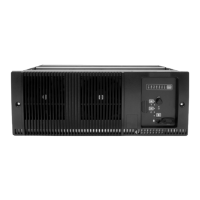TB9100 Reciter Service Manual Network Circuitry 77
© Tait Electronics Limited January 2006
5.7 Audio and E&M Interface
The audio and E&M interface provides a basic four-wire (4W) analog audio
and a DC signalling path into the base station for interconnection with
existing analog infrastructure. It is designed to be compliant with telco
requirements for 4W leased circuits, so that it can be directly connected to
telco cable networks. It is not suitable for connection to the PSTN.
5.7.1 CODEC
A single channel CODEC chip, U500, performs the conversion to/from the
PCM signals from the DSP to the analog interface signals. Internally, this
device supports an independent receive channel and an independent
transmit channel, which together provide a 4W audio interface capable of
full-duplex operation. Both the receive and transmit channels have internal
switching which allows them to be routed to one of two sets of external pins
on the device, but this switching function is not used on the ASIF. Refer to
the CODEC data sheet (reference 15) for details on the internal
architecture.
Note The CODEC data sheet defines the transmit and receive channels
with respect to the PCM interface direction. Hence, data trans-
mitted to the DSP is derived from an input signal from the analog
interface. Data received from the DSP is processed by the
CODEC to become an analog output. The description below
uses the same direction convention.
CODEC Transmit
Operation
Considering first the transmit direction, an incoming signal on the balanced
lines RA and RB passes through EMC filtering components, E507, E508
and C516, and is coupled through capacitor C512 to line transformer T501.
On the secondary side of T501, the incoming signal is divided down with
resistive divider R508, R505 and R509 to match the input level
requirements of the CODEC microphone inputs, MIC1P and MIC1N.
The signal input to the CODEC is internally amplified, converted to digital,
filtered and sent to the DSP over the PCM interface. The other microphone
inputs, MIC2P and MIC2N, are not used and are shorted together through
C504.
The combined total of R505, R508 and R509 provides the correct
transformer loading to present a 600Ω load to the line input. Capacitors
C508 and C510 compensate for the leakage inductances in the transformer
to optimize the input return loss at the upper end of the audio band.
CODEC Receive
Operation
In the receive direction the digital data received from the DSP is digitally
attenuated and filtered, converted to analog and then applied to an output
routing switch. This switch routes the output signal to an output power
amplifier, and subsequently to balanced outputs, EAR1OP and EAR1ON.
The unbalanced output, EAR2O, is not used in the ASIF design.

